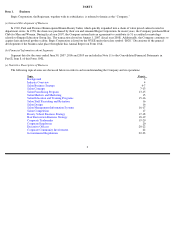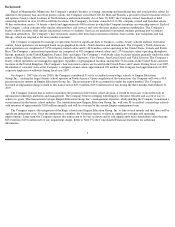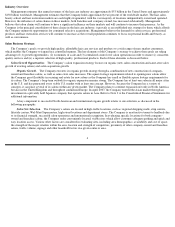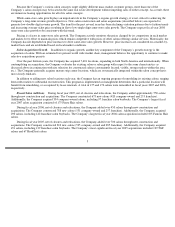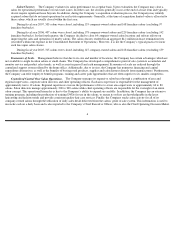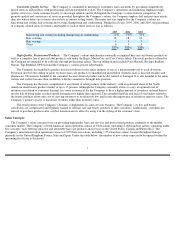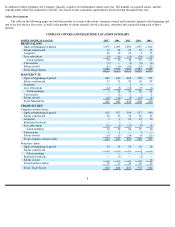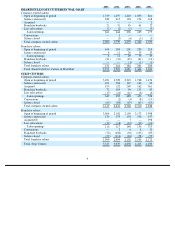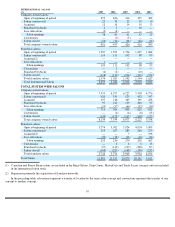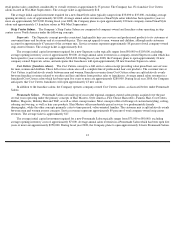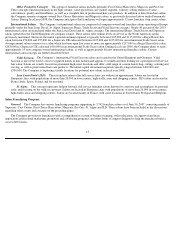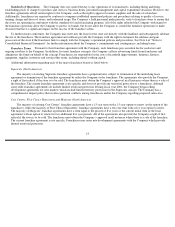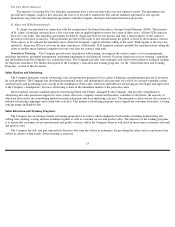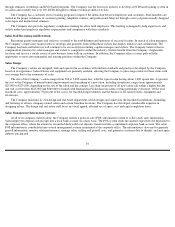Supercuts 2007 Annual Report Download - page 7
Download and view the complete annual report
Please find page 7 of the 2007 Supercuts annual report below. You can navigate through the pages in the report by either clicking on the pages listed below, or by using the keyword search tool below to find specific information within the annual report.
Salon Closures. The Company evaluates its salon performance on a regular basis. Upon evaluation, the Company may close a
salon for operational performance or real estate issues. In either case, the closures generally occur at the end of a lease term and typically
do not require significant lease buyouts. In addition, during the Company’s acquisition evaluation process, the Company may identify
acquired salons that do not meet operational or real estate requirements. Generally, at the time of acquisition limited value is allocated to
these salons, which are usually closed within the first year.
During fiscal year 2007, 303 salons were closed, including 135 company-owned salons and 168 franchise salons (excluding 97
franchise buybacks).
During fiscal year 2006, 407 salons were closed, including 178 company-owned salons and 229 franchise salons (excluding 142
franchise buybacks). In the fourth quarter, the Company decided to close 64 company-owned salon locations and refocus efforts on
improving the sales and operations of nearby salons. The salon closures resulted in an aggregate $4.1 million in lease termination fees
(recorded within rent expense in the Consolidated Statement of Operations). However, it is not the Company’s typical practice to incur
such fees upon salon closure.
During fiscal year 2005, 315 salons were closed, including 147 company-owned salons and 168 franchise salons (excluding 139
franchise buybacks).
Economies of Scale. Management believes that due to its size and number of locations, the Company has certain advantages which are
not available to single location salons or small chains. The Company has developed a comprehensive point of sale system to accumulate and
monitor service and product sales trends, as well as assist in payroll and cash management. Economies of scale are realized through the
centralized support system offered by the home office. Additionally, due to its size, the Company has numerous financing and capital
expenditure alternatives, as well as the benefits of buying retail products, supplies and salon fixtures directly from manufacturers. Furthermore,
the Company can offer employee benefit programs, training and career path opportunities that are often superior to its smaller competitors.
Centralized Control Over Salon Operations. The Company manages its expansive salon base through a combination of area and
regional supervisors, corporate salon directors and chief operating officers. Each area supervisor is responsible for the management of
approximately ten to 12 salons. Regional supervisors oversee the performance of five to seven area supervisors or approximately 60 to 80
salons. Salon directors manage approximately 200 to 300 salons while chief operating officers are responsible for the oversight of an entire
salon concept. This operational hierarchy is key to the Company’s ability to expand successfully. In addition, the Company has an extensive
training program, including the production of training DVDs for use in the salons, to ensure its stylists are knowledgeable in the latest
haircutting and fashion trends and provide consistent quality hair care services. Finally, the Company tracks salon activity for all of its
company-owned salons through the utilization of daily sales detail delivered from the salons’ point of sale system. This information is used to
reconcile cash on a daily basis and is also reported to the Company’
s Chief Executive Officer, who is also the Chief Operating Decision Maker.
6



